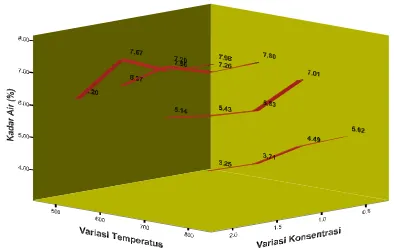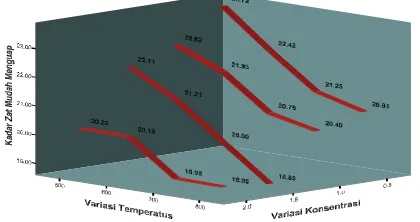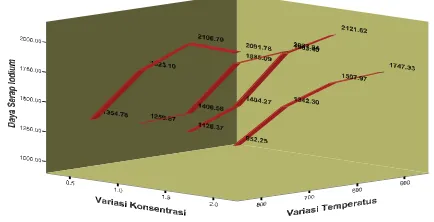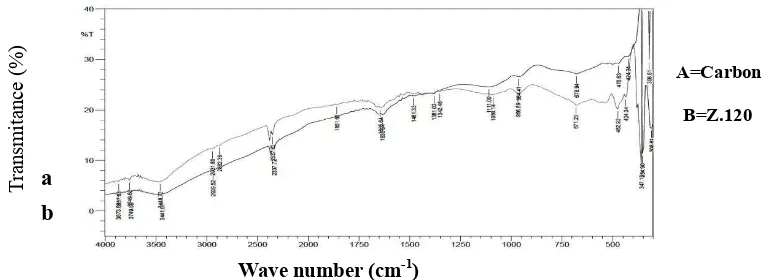C-4
EFFECT ACTIVATION OF CHEMICAL AND PHYSICAL TO STRUCTURE AND ACTIVATED CARBON QUALITY FROM CHARCOAL OBTAINED BY
PYROLYSIS OF COCONUT SHELL
Djefry Tani1*, Bambang Setiaji2, Wega Trisunaryanti2, Akhmad Syoufian2
1 Doctoral Student, Chemical Department, Gadjah Mada University, Yogyakarta 2 Chemical Department, Faculty of Mathematics and Science Gadjah Mada University
*Chemical Department, Manado State University *Phone: +6285228231954, e-mail: [email protected]
Abtract
Activation of coconut shell charcoal has been done by a combination of chemical and physical activation to determine the effect of chemical activators and activation temperature to changes in the chemical structure and the quality of activated carbon . The study was conducted on charcoal coconut shell of pyrolysis results with variation of concentration and immersion time ZnCl2 as an activator , respectively 0.5 to 2 M for 12
to 24 hours . Then proceed with the activation of physics in reactor the activation of the temperature variation of 500 to 800 oC with CO
2 gas flow rate 20 mL / min . Evaluation
of the chemical structure and the quality of activated carbon performed FTIR , SEM , specific surface area , total pore volume , and average pore with Brunauer - Emmett - Teller ( BET ) . The results showed the results of the analysis of SPSS through Cofficients test the concentration variables most affect to moisture content , ash content , and iodine absorption from temperature variable and time of activation . The best quality activated carbon produced at a concentration of ZnCl2 of 1.5 M, 24 hours soaking time of
24 hours , temperature 800 oC and the activation time of 120 minutes . The results as
moisture content of 8.47 % , volatile matter content of 18.55 % , ash content 1.44 % , bonded carbon content of 80.01 % and iodine absorption of 769.74 mg / g . The results of FTIR analysis showed the surface of activated carbon containing CO and CH bonds , and SEM analysis showed the number and diameter of pores increased with the higher calcination temperature . Surface area ( BET ) of 359.286 m2 / g , pore volume of 1.984 x
10-1 cm3 / g and pore mean of 11.46 Ǻ .
Keywords : coconut shell, activated carbon , ZnCl2 , SPSS , FTIR , SEM , BET
Introduction
component consists of fixed carbon, ash, water, nitrogen and sulphur. Coconut shell charcoal from pyrolisis process is potential to process as active carbon (Scok et al, 2005). Active carbon product from coconut shell charcoal has many micropore, high surface area and high adsorption capacity (Keneeth, 2002; Manocha, 2003).
Process of making active carbon consists of two steps: carbonization process and activation process. Main product resulted from carbonation process is charcoal with side product of tar, liquid smoke and carbon. However, resulted carbon has low surface area and usually less active due to very small adsorption rate. So, it is necessary followed with activation process functioning to develop porosity and adding surface area (Rodenas et al, 2005; Cuhadaroglu and Uygun, 2008).
Activation method commonly used in making active carbon is physical and chemical activation. Physical activation process is charcoal activation to develop pore from active carbon with aid of hot vapor and inert activating gas in high temperature of 800 to 11000C (Teng et al, 1998; Hong et al, 2000; Lee and Lee, 2001). Activation temperature is a variable that very influence characteristic of active carbon. In high temperature condition without air will resulted high quality active carbon where volatile components will loss so fixed carbon level is high. Chemical activation is a process of cutting carbon chain from organic compound using chemical material as activator (Derbyshier et al, 1995). Some activators commonly used in making active carbon are KOH, NaOH, ZnCl2, KCl, H3PO4 HCl and so on (Sricharoenchaikul et al, 2008; Babel, 2004). However, in other side, making active carbon with only chemical activation has weakness of corrosion process, washing process and cannot regulate resulted active carbon pore (Balci et al 1994; Sricharoenchaikul, 2008; Timur et al, 2006).
This research studied activation process of coconut shell charcoal from pyrolisis process using chemical activation and physical activation using ZnCl2 as activator with CO2 activating gas. The combination method is expected to make active carbon at lower temperature, easier and at lower cost but with high commercial value. The combined method will result in high quality active carbon with greater surface area and high adsorption capacity. It will contribute to science and technology of making active carbon useful for industry in the future and it can develop optimally distribution of pore dimension according to industry desire.
Experimental Material
Coconut shell resulted from pyrolisis from PT TNI, ZnCl2, gas CO2, Kl, Na2S2O35H2O, distilled water, KIO3, I2, HCl
Instruments:
A set of pyrolisis tool, a set of activating reactor, 100 mesh and 80 mesh sieve, electronic balance, oven, desiccator, electric furnace, magnet stirring, pH meter, laboratory glass tools.
Procedure
Preparation of coconut shell sample
Coconut shells were cleaned and their dimension were decreased to about 3 x3 cm, and weighted for 1500 gram and used as pyrolisis sample.
Carbon activation step
1. Chemical activation step
In this step coconut shell charcoal from pyrolysis that has been sieved was soaked in ZnCl2 solution with various concentration and soaking duration (0.5 – 2.0 M and 12 to 24 hours). Charcoal that have been soaked was sieved with vacuum filter and heated in oven at 1200C for 2 hours to produce dry charcoal then put into desiccator.
2. Physical activation step
Charcoal resulted from chemical step was put into tube furnace activation reactor given with glasswool at lower and upper part, then activated at various temperature (500 to 8000C) and flowed with CO2 20 ml/minute for two hours. Then, the charcoal was soaked in 1M HCl solution for 24 hours. Then the charcoal was washed with distilled water to make neutral filtrate (measurement with pH meter). It was sieved and dried in oven at 1100C for two hours. Active carbon was ready to analyze
3. Active carbon analysis
Active carbon test including physical and chemical characteristic consist of macro and micro analysis. Macro analysis includes moisture content, volatile content, ash content, fixed carbon content, and adsorption capacity iodine. Result of macro analysis is tested with coefficient test using SPSS. Analysis of micro structure include function group with FTIR, surface structure with SEM, BET surface area, total pore volume and average pore diameter.
Fourier Transform Infra red (FTIR) analysis
Active carbon sample structure of activation result was analyzed using Fourier Transform Infrared (FTIR) Shimadzu model IR-prestige-21 and made pellet KBr. It was used to identify mineral function group.
Scanning electron microscopy (SEM)
Scanning electron microscopy (SEM) was used to analyze micro structure of surface of active carbon before and after activation.
BET surface area analysis
Pore structure analysis and surface area analysis was done using surface area analyzer Nova ver 2.2. Determination of surface area was done with BET method to calculate surface area of active carbon resulted from pyrolisis of coconut shell charcoal. In addition with BET equation, total pore volume and average pore radius may be determined.
RESULT AND DISCUSSION
This research was done to identify effect of chemical treatment using ZnCl2 activator in making active carbon from coconut shell charcoal using chemical and physical activation methods.
Moisture matter of active carbon
Figure 1. Effect of ZnCl2 concentration and temperature on moisture content of active carbon
Figure 1 reveals that grater concentration of activator solution used in active carbon soaking will result in higher moisture content. Soaking process with activator was done to reduce tar content, so the more concentrated activator the less tar content in carbon. In result, pore in active carbon is increasingly great and much. Greater and more pore lead to increase in its hydroscopic characteristic. It causes adsorption of water from atmosphere by active carbon will increase, which lead to increase in moisture content in the active carbon.
Coefficient test indicates three independent variables on moisture content (%) is temperature (16.159), concentration (12.110) and soaking duration (4.822) (see t count in t column t in coefficient table). Result of multiple regression test using SPSS software indicate that the three variables affect water content.
Ash content
[image:4.612.154.354.472.574.2]Process of testing ash content will indicate ash of metal oxide in charcoal consisting of mineral that can evaporate in incineration process. Effect of activator concentration on ash content in active carbon is presented in figure 2.
Figure 2. Effect of ZnCl2 concentration and temperature on as content of active carbon
Figure 2 shows that ash content of all active carbon obtained in this research fulfill SII no 0258-79 (maximal 10%) because it was about 0.55-1.44. at activator concentration of 0.5-2.0 M, ash content increased. It relates to forming pores in active carbon. Ash content in active carbon also relates to raw material and its process. High activator concentration will add surface area of active carbon due to great and many pores. Active carbon consists of layers piling to each other making pore. During pore forming, there occur crystal field burning that resulting ash. The more pore made, the more ash produced.
Coefficient test indicated three independent variables affecting ash content are
Dot/Lines show Means
temperature (7.296), concentration (-2.501)and soaking duration (1.096) (see t count in t column t in coefficient table).
Volatile matter content
[image:5.612.155.365.235.346.2]Volatile substance in active carbon consists of water and tar residue that does not fully disappear in carbonization process. Obtained data indicated that volatile substance content in active carbon obtained in this research still comply with SII no 0259-79 (25%), as indicated in figure 3.
Figure 3. Effect of ZnCl2 concentration and temperature on volatile matter content of active carbon
Figure 3 indicated that higher concentration of activator solution will decrease volatile substance. So, higher ash content indicated lower volatile substance content in active carbon. It is due to absorbed activator will cause erosion in carbon, which reduce efficiency of heating process in activation. In other words, temperature of activation process is low. When activation was done in low temperature, then volatile substance content will increase. Then, decomposition of non carbon compound such as CO, CH4 and H2 is expected not perfectly running. The graphic indicated that various concentrations can reduce volatile substance content but their decrease is not great so did no affect the volatile matter.
Based on coefficient test, the three independent variables most influencing volatile matter content are temperature (-4.021), concentration (-3.233) and soaking period (-2.126) (see t count in t column in coefficient table).
Fixed carbon content
Fixed carbon content is carbon obtained based on deduction of all sample weight (100%) on volatile matter and ash content. Fixed carbon content in active carbon was 50%-90%. Therefore, main composer of active carbon is carbon. The data indicated that highest fixed carbon content resulted from carbon activated with 1.5M ZnCl2, with 24 hour soaking period and at 8000C. Fixed carbon content obtained with various concentration still comply with SII no 0258-79 (at least 65%). The data is presented in figure 4.
Figure 4. Effect of ZnCl2 concentration and temperature on fixed carbon content of active carbon
Figure 4 indicated that increase in activator solution concentration will increase fixed carbon content. Factors influencing increase in carbon content are ash content and volatile matter content. Lower ash content and volatile matter content in active carbon indicated higher fixed carbon content. Therefore, purity of active carbon will be higher.
Based on coefficient test, the three independent variables most influencing fixed carbon content are temperature (3.418), concentration (3.400) and soaking period (2.023) (see t count in t column in coefficient table).
Iodium number
Adsorption of aqueous iodine is one of main characteristics of active carbon determining quality of active carbon. Test result indicated that active carbon having best adsorption number iodine is that in 1.5 M concentration (769.74 mg/g). The adsorption number
[image:6.612.153.370.455.566.2]on iodine resulted in this research comply with SII no.0258-79 (at least 200 mg/g).
Figure 5. Effect of ZnCl2 concentration and temperature on iodine adsorption number active carbon
Figure 5 reveal high activator solution will increase adsorption number over iodine. It is cause due to tar content in active carbon increasingly decrease with increasing activator concentration at soaking, where soaking process with activator was done to reduce tar content. Therefore, more concentrated activator solution used indicates decrease in tar content in active carbon. It causes greater pores in active carbon or increase in surface area of active carbon. The grater surface area of active carbon, the higher absorption number it has.
Based on coefficient test, the three independent variables most influencing adsorption
Dot/Lines show Means
number iodine are temperature (12.668), concentration (9.417) and soaking period (3.964) (see t count in t column in coefficient table).
Analysis of function group using active carbon FTIR before and after activation with activator Zinc chloride (ZnCl2) at concentration of 1.5 M, 24 hour soaking period and
[image:7.612.114.497.175.315.2]8000C
Figure 6. FTIR spectrum of carbon before and after activation with various activation periods
The FTIR spectrum of coconut shell charcoal of pyrolisis without activation informs presence of absorption band in wave number 3487.3-3417.86 cm-1 appearing stretching vibration of O-H group. This vibration is supported with absorption band in wave number 1381.03-1165 that is stretching vibration of C-O and bending vibration of OH from alcohol and carboxylate acid. In addition, in wave number 2337.72 cm-1 is stretching vibration of carboxylate acid. Wave number 1581.63-1527.62 cm-1 is stretching vibration of C=C in aromatic ring. Absorption band 802.39-747.38cm-1 indicated C-H out of plane bending in aromatic ring.
The spectra of the prepared activated carbon resulted from activation with ZnCl2 is relatively similar to shell charcoal without activation. However, its absorption rate decrease or increase according to activation duration so there is shift in wave number. Absorption band in wave number 3448.72 cm-1 appear stretching vibration of O-H. The vibration is supported by absorption band in wave number 1342-1080.14 cm-1 that is stretching vibration of C-O and bending vibration of OH from alcohol and carboxylate acid. In addition, there is absorption in wave number 2337.72 cm-1 that is stretching vibration of carboxylate acid. While in wave number 1635.64 cm-1 is stretching vibration of C=C in aromatic ring. Absorption band in wave number 802 cm-1 indicate C-H out of plane bending in aromatic ring. Change in function group structure in active carbon may be due to effect of charcoal calcination temperature and duration of activation. Active carbon resulted in activation process has absorption pattern with bonding type –OH, C-H, C –O, and C=C. OH and C=O bonding indicated active carbon tend to be polar so active carbon can be used as adsorbent.
Active carbon analysis with scanning electron Microscope (SEM)
Carbon before and after activation process was analyzed using SEM. Result of imaging using SEM describing carbon surface is presented in figure 7 and 8.
Tra
nsmi
tan
ce (
%)
Wave number (cm-1)
a b
A=Carbon
Figure 7. SEM photograph of coconut shell charcoal before activation with 1500 times and 2500 times magnification
Figure 8. SEM photograph of coconut shell charcoal after activation at 1.5 M ZnCl2 concentration, 24 hours soaking, at 8000C and 120 minutes activation period with 1500 times and 10.000 times magnification
Figure 7 and 8 indicates shows active carbon before and after activation with activator ZnCl2. Result of SEM before activation indicate much impurity covering pore surface of the carbon (figure 7) compared with after activation (figure 8) in which carbon pore surface more porous. It indicates that activation process can open and shape new pore in carbon. New pore shaping appear in pore diameter distribution
Characterization of active carbon from coconut shell charcoal with nitrogen adsorption-desorption
[image:8.612.92.503.238.340.2]Figure 9. Isotherm of adsorption-desorption of active carbon resulted from activation
[image:9.612.153.464.366.509.2]Activation of active carbon from coconut shell charcoal have changed its characteristic. It is due to effect of active carbon cavity blocking by cation after activation process. Distributions of active carbon pore dimension before and after activation increase significantly as revealed in figure 10. The figure shows that distribution of active carbon pore dimension after activation with ZnCl2 has peak around pore radius 11.04 Å so dimension of the active carbon pore is mesopore.
Figure 10. Distribution of active carbon pore dimension before and after activation
Surface area, pore size and pore volume is very important characteristic for material function as adsorbent because it determine measurement of internal surface available for active site. Parameter of active carbon pore structure before and after activation may be seen in table 6. The table indicates that active carbon before and after chemical activation with activator ZnCl2 and physical activation at concentration of 1.5M soaking duration of 24 hour at 8000C and 120 minutes activation period change pore structures of surface area, pore radius and pore volume.
Table 1. BET surface area, total pore volume, average pore radius of active carbon
Totalpore volume Average pore 0 200000 400000 600000 800000 1000000 1200000 1400000
0.00E+00 2.00E+04 4.00E+04 6.00E+04 8.00E+04 1.00E+05 1.20E+05
V olum e po rei (cc/g)
Relative pressure (P/P0)
Arang Z-120 0 0.00005 0.0001 0.00015 0.0002 0.00025 0.0003 0.00035 0.0004
0 100 200 300 400 500 600 700 800
vo lu me p orei d Vr (cm 3 / Ǻ /g10 -3)
average pore radius [Ǻ]
[image:9.612.106.506.644.702.2]Table 1 indicates that active carbon surface area before and after activation increased from 15.4561 m2/gram to 317.1 m2/gram along with increase in ZnCl2 activator concentration and activation temperature (1.5M and 8000C). It is due to at 8000C, volatile substances or non volatile substance will discharge from pore that will form new pore and increase surface area and pore volume and decrease average pore radius.
Conclusion
1. Result of SPSS analysis on coefficient test indicated temperature most influence moisture content, volatile matter, ash content, fixed carbon content, iodine number compared concentration and soaking duration variables.
2. Active carbon resulted from activation process has adsorption pattern with binding types of O-H, C-H, C-O, and C=C. O-H and C=O bonding indicates active carbon tending to be more polar that can be used as adsorbent. Effect of carbonization process and activation can increase aromatic compound as composing hexagonal structure of charcoal and active carbon.
3. Chemical and physical activation of coconut shell charcoal with ZnCl2 activator affect characteristic of active carbon. It may be seen in morphology of surface structure that is more porous and greater surface area.
4. Best active carbon obtained in ZnCl2 concentration of 1.5 M, 24 hour soaking duration, 8000C and 120 minutes activation duration. The condition resulted in 8.47% moisture content, 18.55% volatile matter, 1.44% ash content, 80.01% fixed carbon and 769.74 mg/g iodine number.
5. Active carbon from activation with various activation has similar pattern, smaller pore diameter and grater pore volume than that without activation. The active carbon has BET surface area of 359.286 m2/g, pore volume 1.984 x 10-1cm3/g and average pore radius of 11.045 Å.
References
ASTM International., 2006, Annual Book of ASTM Standards, Section 5 : Petroleum product, Lubricant, and Fossil Fuels, 05(06) : Gaseous Fuels; Coal and Coke.
Babel, K., Jurewicz, K., 2004, KOH Activated Carbon Fabrics as Supercapacitor Material,
J.Phys. Chem. Sol., 65, 275-280
Balcı, S., Doğu, T., And Yücel, H., 1994, Characterization of Activated Carbon Produced from Almond Shell and Hazelnut Shell, J. Chem. Tech. Biotechnol., Vol.60, 419-426
Bansal, R. Ch., and Goyal, M., 2005, Activated Carbon Adsorption, Taylor and Francis Group Cheremisinoff, N.P., 1978, Carbon Adsorption Handbook, Ann Arbor Science Publishers Inc,
Michigan
Cuhadaroglu, D dan Uygun, O.A., 2008, Production and Characterization of Activated Carbon from a Bituminous Coal by Chemical Activation, Afr. J. Biotechnol., Vol. 7(20), 3703-3710
Hong, E.H., Jung, Y.H., and Lee, K. H., 2000, Preparation of Mesoporous Activated Carbon Fibers by Catalytic Gasification, Korean J. Chem. Eng., 17, 237
Jankowska, H., Swiatkowski, A. and Choma, J., 1991, Active Carbon, Ellis Horwood, New York Kenneth, C. L., Nasrin, R. K., Marta, C., Giselle, S, and Thiyagarajan, P., 2002, Microstructural Analysis of Carbons Prepared from Paper Mill Slugle by SANS and BET, Chem. Mater., 14, 327
Lee, S. H., and Lee, C. D., 2001, Influence of Pretreatment and Activation Condition in the Preparation of Activated Carbons from Anthracite, Korean J. Chem. Eng., 18, 26 Mandey, L.L., 2007, Biokonversi: Teknologi Pemanfaatan Limbah Industri Pertanian, Sidang
Manocha, S. M., 2003, Porous Carbons, S adhan Vol. 28, Parts 1 dan 2, Feb/Apr, 335-348 Rodenas, L., Castello, L., Amaros, C., Solano, L., 2005., Preparation of activated Carbons from
Spanish anthracite Part 1. Activation by KOH, Carbon, 39 (5), 741-749
Scok, J.s., Jung, S.C., Ko. Y.C, and D.S. Sun, 2005, Development of Carbon Dioxide Adsorbents Using Carbon Materials Preparated Coconut Shell, Korean J. Chem. Eng 22:291-297.
Smisek, M. and Cerny, S., 1970, Active Carbon, Manufacture, Properties and Applications, Elsevier Publishing Company, New York
Sricharornchaikul, V., Pechyen, C., Aht-ong, D., Atong, D., 2008, Preparation and Characterization of Activated Carbon from the Pyrolysis of Physic Nut (Jatropha curcas L.) Waste, Energ. Fuels, 22, 31-37
Teng, H., and Yeh, T. S., 1998, Preparation of Activated Carbon from Bituminous Coals with Zinc Chloride Activation, Ind. Eng. Chem. Res., 37, 58-65





